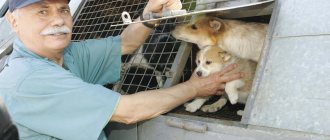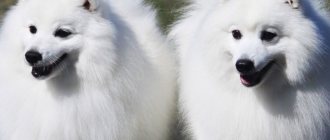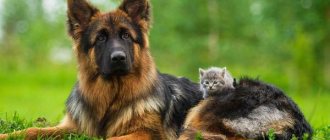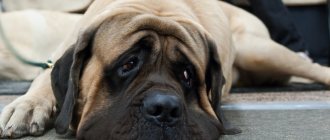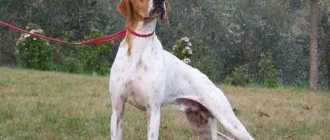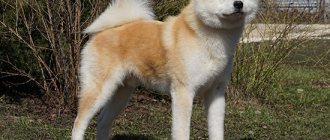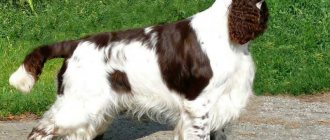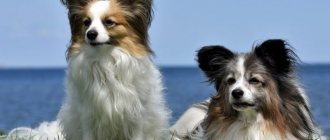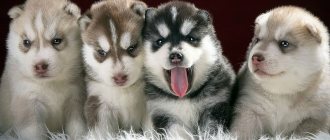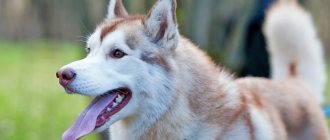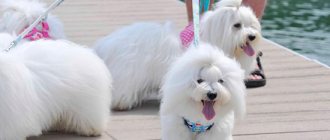History of the breed
First of all, you should understand how the pointer differs from the shorthaired pointer. The answer is nothing. These are different names for the same breed. Fans of scanword puzzles have probably even come across this task more than once - “German Pointer, 8 letters.” The correct answer will be the shorthaired pointer.
In general, the breed appeared in Germany a very long time ago, back in the days when birds were hunted with nets. But the shorthaired pointer gained particular popularity after firearms began to be widely used in hunting. And solid standards were approved at the end of the nineteenth century by Prince Albert of Solms-Braunfels.
Fact ! The breed was included in the FCI register in 1954.
Description of the breed
This is a rather large, but at the same time lean dog. The height of males at the withers is about 62-66 cm. Bitches are a little smaller - about 58-63 cm. Well, they weigh about 25-32 and 20-27 kg, respectively. So, despite their impressive dimensions, they cannot be called massive.
Selecting shorthaired pointer puppies
The ideal age for purchasing a puppy is one month. The baby is already quite independent and does not require breastfeeding. At first he will miss his mother, but will quickly get used to the new conditions. The main thing at this stage is to give the puppy a lot of attention, not to scold him, to help him adapt, and to establish emotional contact.
Many people are not ready to take care of a very tiny puppy, so they prefer to choose older dogs. This approach has its advantages. Owners will need less time to care for the animal. On the other hand, training a one-month-old puppy “to suit you” is much easier.
It is not recommended to buy adult dogs (over a year old). First, they don't handle changes in ownership as well. Secondly, it is difficult to wean them from familiar habits and behavior.
If a dog is purchased exclusively for hunting, you should pay attention to puppies with a good pedigree. When choosing, focus on:
- parents' achievements;
- pet’s appearance (clean ears, eyes, skin and fur);
- physique, posture;
- behavior (no signs of aggression or cowardice).
A puppy from titled parents is expensive, up to 25 thousand rubles, from less famous parents - from 10 thousand. You should buy animals only from experienced and trusted breeders, but in no case from your own hands.
| Author of the material: Margarita Olegovna Samusik journalist, ecologist, curator of materials on animals, birds, nature |
Advantages and disadvantages
If we talk about the advantages that distinguish German pointers, then it is immediately worth highlighting:
- friendliness,
- excellent skills as a hunter and watchman,
- sharp intelligence, simplifying training,
- good health,
- ease of care,
- low level of aggression.
But this is not without its drawbacks. The main one is very high activity. The dog must run a lot and often. He is perfect for keeping in his own home, where there is a spacious area, but life in the same apartment with him can turn into real hell.
Key points in training
The German Smooth Black Pointer is very active and dynamic. He must get the required dose of exercise regularly. Dogs are highly trainable. To do this, it is important to provide them with decent compensation. It is always interesting for a dog to work in tandem with its owner.
Any dog should know at least basic commands. Kurzhaar is no exception. If you teach your puppy strict discipline, then it will not be scary to walk with him in the forest or in the city. He definitely won't run away.
Training begins from the day the puppy is brought home. From 2.5 months, the owners accustom him to the following commands:
- Sit;
- Stand;
- Lie;
- Near;
- Aport;
- Voice.
If the owner has no experience in training and is unable to train the puppy, it is better to turn to a specialist.
Breed standard
Each dog breed has set standards by which they are judged during dog shows. Of course, every owner should have an idea about them and be able to distinguish the ideal dog from the one that will be disqualified at the very first show.
Head
Long, dry, proportional to the body. When viewed from above, it resembles a blunt wedge. The cheeks are muscular, flat and strong. The skull is slightly convex, relatively wide.
Jaws and teeth
The bite is correct, scissor-shaped. 42 white, strong teeth, with the correct position of the incisors - on the same line.
Nose
Slightly raised, wide and mobile. The nostrils are wide open. The lobe is brown.
Eyes
Not too large, set slightly obliquely, almond-shaped. Let's assume brown and dark red colors. The eyelids are tight-fitting, dry, with a dark brown edging.
Ears
Moderately thick, not too long. The base is wide, set high - slightly higher than the eye line. Hanging, almost reaching the corners of the lips. Set back and fit snugly to the cheeks. The ends are bluntly rounded.
Neck
Lean, muscular, medium length. Located at an angle of about 40 degrees to the body. Gracefully transitions into the body.
Frame
The body is slightly elongated. The withers are clearly defined and go straight. The back is dry, muscular, wide and strong, smoothly turning into a wide, slightly convex or straight loin. The body ends with a moderately sloping, muscular croup.
Limbs
Lean, muscular, strong bones. The forelimbs are parallel and straight, mounted under the body. The hind ones are slightly set back beyond the ischial tuberosities.
Is it possible to stand here?
Tail
Not very long, can be either a little saber or straight. The base is thick and strong, tapering towards the end. We also accept a standard with docking - two-thirds or half.
When at rest it hangs, and when excited it is raised to the level of the back.
Wool
The coat is short, very dense and thick. On the face and ears a little shorter than on the paws, but also softer.
Color
There may be several options:
- brown, unmarked,
- dark brown-roan with spots or specks,
- light brown with dark head,
- white with brown head and brown spots,
- black with brown spots.
Disqualifying faults
Height discrepancy (deviation in any direction is more than 2 cm). Lack of anger towards the beast and at the same time - unmotivated aggression. Fear of being shot is also a vice.
The dog will definitely be removed from the exhibition if there are such defects as:
- cleft lip,
- cleft palate,
- depigmentation of the lips, eyelids or nose.
Breeding Features
External conformity to the breed is not just a whim. Only if certain factors are present, a dog produces healthy and strong offspring and can withstand the tests of exhibitions. Physically suitable dogs are allowed to be bred in kennels. However, even in this case there is a possibility of marriage. An animal with inappropriate traits will cost much less.
The dog has a spotted coat and toned muscles. She will become a hunting companion. The breed is valued for its versatility. She needs a high level of physical activity. It should not be purchased by people who do not plan to walk in it for at least two hours a day.
Lack of attention turns the dog into an angry and aggressive creature that will be difficult to regain control of.
You can only buy a purebred puppy from official and well-known nurseries. Otherwise, the risk of falling into the hands of fraudsters increases.
Character
Initially, the breed was bred as a hunting dog, but thanks to its devotion, reliability and love for people, it is often acquired as a companion. He treats children with restraint, but never demonstrates aggression.
But the same cannot be said about pets. A cat or guinea pig can be torn apart - he does not see the difference between them and prey. In addition, without socialization in puppyhood, the grown-up dog will run into conflicts with other dogs.
Interesting !
In some European countries, the shorthaired pointer is included in the list of the most common breeds.
German Shorthaired Pointer (Kurzhaar)
The German Shorthaired Pointer combines many of the qualities characteristic of popular breeds of hunting dogs. A keen sense of smell combined with extreme intelligence (the basic characteristics of this breed) were the result of carefully thought out crossings with the descendants of ancient Spanish Pointers, English Foxhounds and local German hounds. Its abilities are so versatile that the breed has earned a reputation as an all-rounder (a term coined by the Germans before American hunters began importing the dog in the early 1920s).
Indeed, it is difficult to imagine a dog that combines the firm stance of a pointer, the keen scent of a hound, and the ability of a retriever to fetch game from a swamp or pond. In addition, he is a reliable watchman and devoted friend. This beautifully built and colored dog is extremely hardy.
The versatile talents of this dog are evidenced by its successful use in hunting pheasant, quail, black grouse, partridge, woodcock, duck, hare, raccoon and opossum. The German Shorthaired Pointer is also used in deer hunting. Its waterproof coat and webbed feet help it locate game in heavily marshy areas and serve it even from icy water.
The origin of the German Shorthaired Pointer, as well as many other breeds, cannot be determined with sufficient accuracy. Before the founding of the Klub Kurzhaar studbook in the 1870s, there were almost no reliable sources. The German hunting fraternity has spent decades trying to develop a versatile, versatile breed, using local varieties of hunting dogs as necessary. The breed is apparently based on one of the types of the German gun dog - an ordinary distant descendant of the Spanish pointer.
Its working qualities were further improved by infusing the blood of local scent hounds, which worked reliably even on water and were used by German foresters. These Schweiss-hunde (Schweiss - smell, Hunde - dog) were of different types. They were descended from hounds from eastern countries brought to Europe by the Crusaders, and developed mainly in France, where they became the progenitors of almost all modern scent hounds.
However, the Germans did not stop there. Since the dog’s obedience was considered the most important, pointers with this particular quality were selected for mating. Later we fixed the stance, improved the build, but the main attention was paid to instinct. First-class pointers were brought from England, which added elegance to the breed in work and introduced their die hohe nase (high nose). The goal was achieved, and then the breeders were left with only one problem: how to combine the love of water and aggressiveness towards predators with the characteristics of the Pointer. This problem was soon solved. As a result, a magnificent breed was obtained, combining versatile working qualities with beautiful appearance, a strong nervous system and enviable longevity. All this has made the shorthaired pointer a favorite of hunters all over the world.
The German Shorthaired Pointer was entered into the AKC Stud Book in March 1930. The first licensed exhibition of the breed was organized by the German Shorthaired Pointer Club of America at the Chicago International Dog Show on March 29-30, 1941; the first licensed field trials took place in Anoka, Minnesota on May 21, 1944.
Education and training
A good assistant for a hunter
is devoted to his Master and does not test his strength. But still, one should not once again allow the dog to do something that will be prohibited in the future. Once having demonstrated the line beyond which one should not go, the owner will not know the problems.
A sharp mind allows you to quickly master all commands, including quite complex ones. True, achieving perfect execution is often difficult - after all, this is a hunting dog, not a working dog. But, of course, the dog must know the basic minimum.
Description and distinctive features
First of all, shorthaired pointers are hunting dogs. Although keeping in a city apartment is possible subject to constant physical activity and active walks. The physique is characterized by an elegant shape and excellent posture.
Even when not standing, the dog’s body is distinguished by smooth, regular lines. Shorthaired Pointers take the hunting stance instinctively. This arrow-like pose is characterized by:
- low head;
- raised front paw;
- straightened tail;
- gaze fixed on prey.
Even a very small puppy will take this position if it sees a feather.
The head, with a slightly elongated muzzle, is proportional to the body. The limbs, especially the hind limbs, are well developed. Thanks to this, the dog jumps high and easily covers long distances.
The average life expectancy is 10–13 years.
Features of feeding and diet
There are no special problems with the diet. The dog eats both dry food and natural food well. True, when choosing drying, it is advisable to choose high-quality and expensive varieties. The cheap ones don't have meat or even offal, only soy. On such food, the dog will obviously get sick more often than he would like.
With natural food, everything is simple - lean meat and offal are used as a base. The addition will be porridge and fresh, grated vegetables - a source of carbohydrates and vitamins.
Healthy ! The dog has coarse and short hair - blood-sucking insects pose almost no danger to the pet.
Rules of maintenance and care
The Shorthaired Shorthaired Pointer is an unpretentious breed. During the maintenance process, you must adhere to the following rules:
- A personal space should be organized for her in the house.
- Every day you will have to walk the dog at least three times for 40 minutes. Kurtz Hart gets the opportunity to run around to his heart's content. Physical activity is an integral component of health and longevity.
- The shorthaired pointer should be bathed no more than once every two weeks. Special shampoos for dogs are used.
- Trimming nails - once every 2 weeks. The procedure is performed using a special tool. Otherwise, the risk of damage to the nail plate increases.
- Inspection of the ear cavity with removal of dirt - 2 times a week.
- Once a day, you need to wipe your dog’s eyes with a damp cotton swab.
- Feeding is done at least twice a day. The diet should not contain fatty foods. If the dog eats dry food, then one feeding will be enough. Even if the dog eats well, three ribs should be visible. Coat change occurs three times a year. To speed up the process, it is advisable to use a special brush.
Purebred dogs are unpretentious
Health
The average life expectancy of Pointers is 12–14 years. It would seem that the short life span can be explained by the high loads that the dog endures due to its temperament. Moreover, whether the four-legged dog hunts is not so important; proper maintenance of the Pointer requires very active walking.
Diseases characteristic of the breed are very predictable and almost all of them are firmly “hardwired” into its DNA:
- Hip dysplasia Typically, older animals whose metabolism is naturally slowed down suffer from the pathology.
- Arthritis is a collective concept indicating joint pathology, which is accompanied by inflammatory processes. May lead to chronic pain, susceptibility to injury, or thinning of cartilage tissue.
- Skin diseases - itching, rash, eczema, hair loss, ingrown guard hairs. The reason may be poor nutrition, poor-quality fabric of overalls, frequent bathing, blood-sucking parasites, antibiotic treatment, etc.
- Pannus (chronic superficial keratitis) is a pathology that leads to the formation of a scar under the cornea. Usually, the disease is discovered after a severe inflammatory process, for example, entropion, conjunctivitis or injury.
- Cataracts are most often (but not always) an age-related pathology that leads to clouding of the lens of the eye and deterioration of vision.
- Corneal dysplasia is an age-related pathology that leads to modification or even detachment of the cornea of the eye, i.e. blindness. The cause may be abnormal loads, stress, trauma, poisoning, aggressive treatment of other pathologies, or degenerative age-related processes.
- Progressive retinal atrophy - develops at any age, leads to physical changes in corneal cells or their death for reasons not related to metabolism. Most often, the impetus for the development of atrophy is injury or neglect in care.
- Epilepsy is a neurological disorder that can be the result of injury or occur for no apparent reason.
- Congenital deafness is a degenerative disorder that leads to the death of the cochlea in naive puppies or dogs under the age of 3 months. Typically, pathology is detected at 3 weeks of age, when puppies begin to explore the world around them.
- Cryptorchidism is a defect to which Pointers are no more, but no less prone, than other breeds. Undescended testicles into the scrotum is considered a genetic disease, although it can be corrected with a simple operation. The bottom line is that cryptorchid males are unconditionally rejected from breeding activities, and if this fact was hidden, then the breeder or even the nursery may lose permission for breeding activities.

